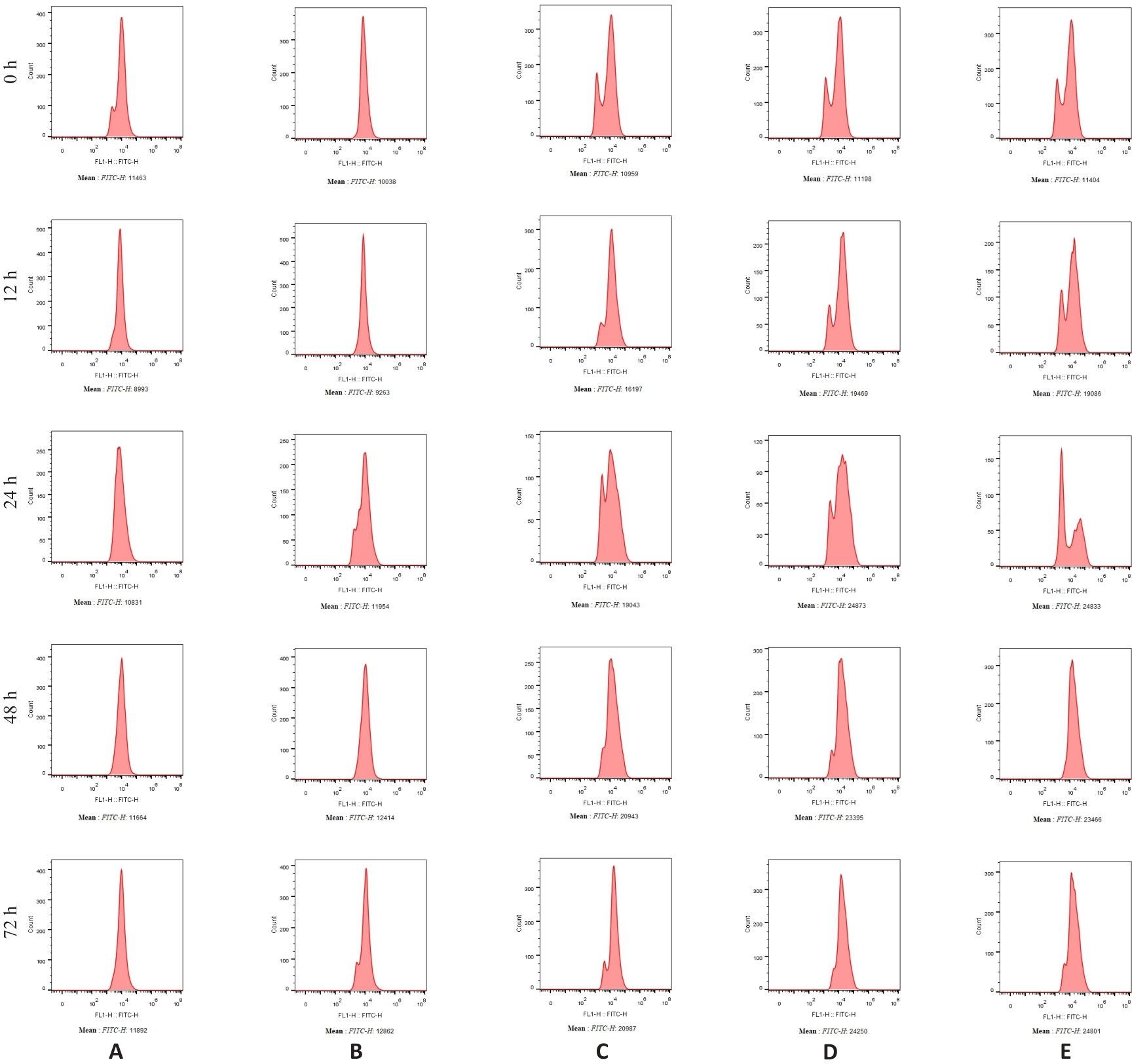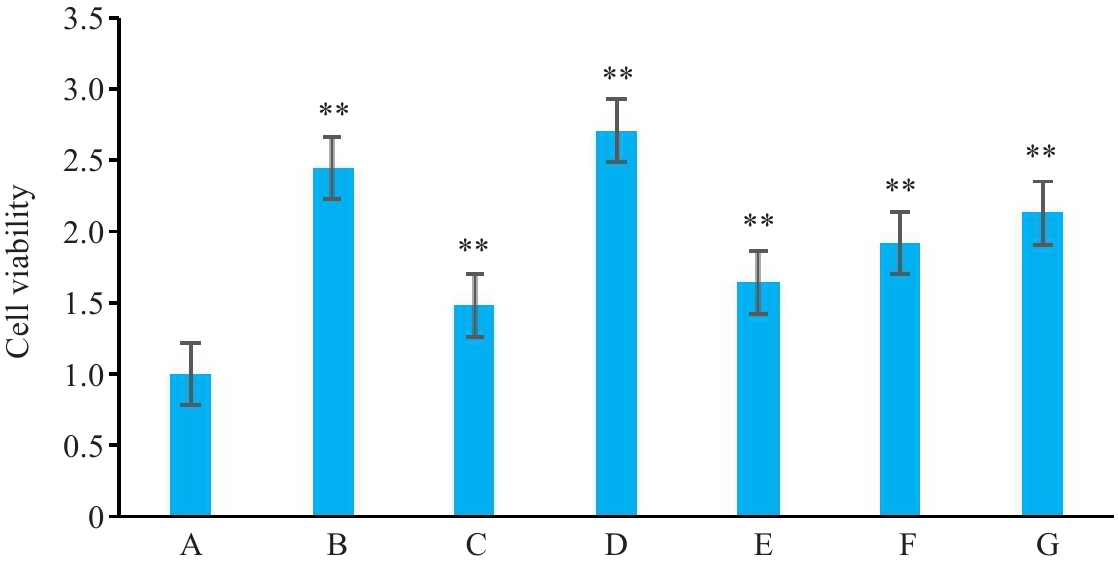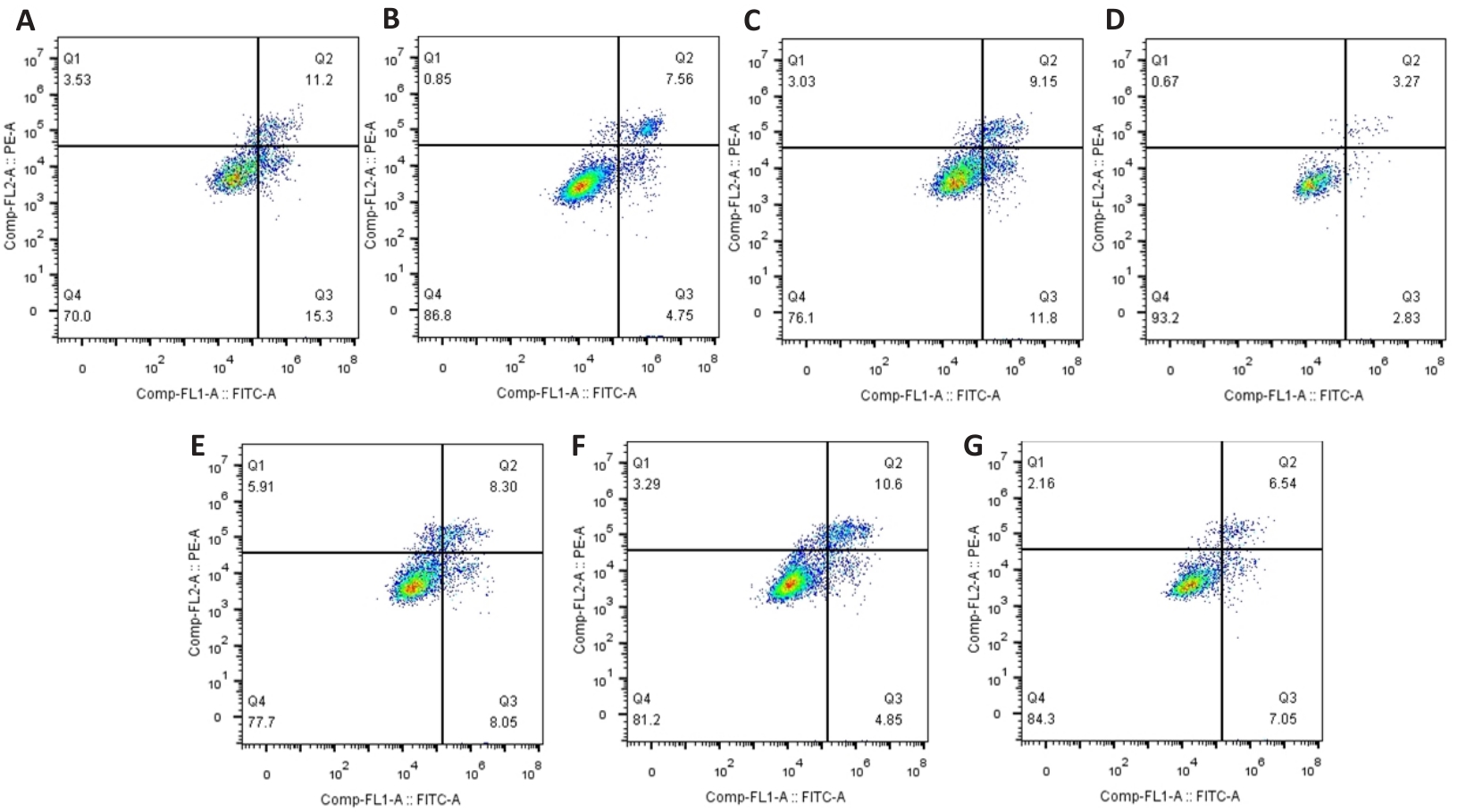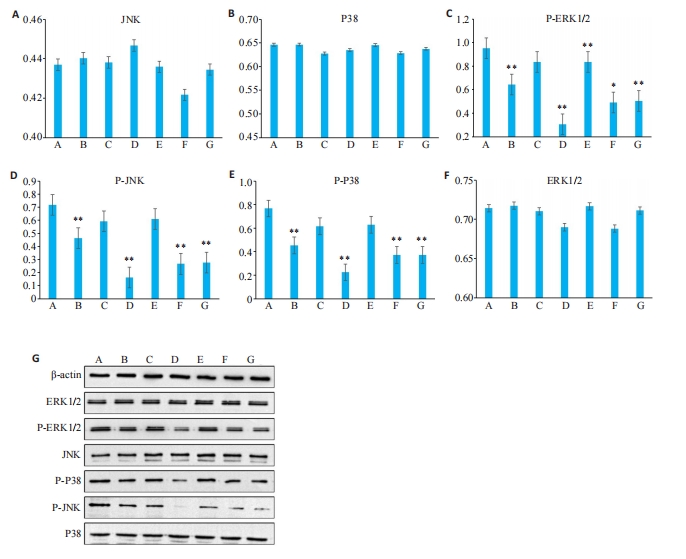南方医科大学学报 ›› 2025, Vol. 45 ›› Issue (1): 80-89.doi: 10.12122/j.issn.1673-4254.2025.01.11
徐朦1( ), 陈丽娜2, 吴金玉3, 刘丽丽4, 施美4, 周灏4, 张国梁4(
), 陈丽娜2, 吴金玉3, 刘丽丽4, 施美4, 周灏4, 张国梁4( )
)
收稿日期:2024-09-06
出版日期:2025-01-20
发布日期:2025-01-20
通讯作者:
张国梁
E-mail:1025473030@qq.com;zhangguoliang61@sina.com
作者简介:徐 朦,在读博士研究生,E-mail: 1025473030@qq.com
基金资助:
Meng XU1( ), Lina CHEN2, Jinyu WU3, Lili LIU4, Mei SHI4, Hao ZHOU4, Guoliang ZHANG4(
), Lina CHEN2, Jinyu WU3, Lili LIU4, Mei SHI4, Hao ZHOU4, Guoliang ZHANG4( )
)
Received:2024-09-06
Online:2025-01-20
Published:2025-01-20
Contact:
Guoliang ZHANG
E-mail:1025473030@qq.com;zhangguoliang61@sina.com
Supported by:摘要:
目的 通过网络药理学及分子对接探究“白花蛇舌草-半枝莲”的有效成分及其作用于原发性肝癌的主要生物过程及信号通路。 方法 通过TCMSP、Uniport、Genecards、String数据库以及Cytoscape软件得出最终核心基因;通过ClueGo对药物-疾病共有基因做GO、KEGG富集分析;通过Pubcham、RCSB、Autoduck把药物有效成分与最终核心基因进行分子对接,得出结合能最高药物有效成分;再通过CCK-8、细胞凋亡、Western blotting实验研究此药物有效成分对HepG2的作用。 结果 筛选得出最终核心基因为TP53、ESR1。GO分析显示主要生物过程为BP- regulation of apoptotic signaling pathway,negative regulation of cell population proliferation;CC-membrane raft; MF-protein kinase activity等。KEGG分析显示主要信号通路为Apoptosis,Proteoglycans in cancer,PI3K-Akt signaling pathway,Hepatitis B等。分子对接结果显示,药物有效成分与最终核心基因均可以在自然条件下进行对接,其中ESR1与ursolic acid结合能最高(-4.98 kcal/mol)。CCK-8、细胞凋亡、Western blotting实验显示ursolic acid对HepG2有明显抑制作用。 结论 “白花蛇舌草-半枝莲” 通过多种有效成分与原发性肝癌紧密结合,继而对原发性肝癌起到治疗作用。
徐朦, 陈丽娜, 吴金玉, 刘丽丽, 施美, 周灏, 张国梁. “白花蛇舌草-半枝莲”治疗原发性肝癌的机制研究:基于网络药理学、分子对接及体外实验验证[J]. 南方医科大学学报, 2025, 45(1): 80-89.
Meng XU, Lina CHEN, Jinyu WU, Lili LIU, Mei SHI, Hao ZHOU, Guoliang ZHANG. Mechanism of Hedyotis diffusa-Scutellaria barbata D. Don for treatment of primary liver cancer: analysis with network pharmacology, molecular docking and in vitro validation[J]. Journal of Southern Medical University, 2025, 45(1): 80-89.
| Antibody name | Dilution ratio | Species and genus |
|---|---|---|
| JNK | 1:5000 | Mouse |
| p-JNK | 1:1000 | Rabbit |
| P38 | 1:2000 | Rabbit |
| p-P38 | 1:1000 | Mouse |
| ERK1/2 | 1:1000 | Rabbit |
| P-ERK1/2 | 1:1000 | Rabbit |
表1 一抗稀释液比例
Tab.1 List of the primary antibodies used for Western blotting
| Antibody name | Dilution ratio | Species and genus |
|---|---|---|
| JNK | 1:5000 | Mouse |
| p-JNK | 1:1000 | Rabbit |
| P38 | 1:2000 | Rabbit |
| p-P38 | 1:1000 | Mouse |
| ERK1/2 | 1:1000 | Rabbit |
| P-ERK1/2 | 1:1000 | Rabbit |
| MOL | MOL name | OB% | DL |
|---|---|---|---|
| MOL000098 | quercetin | 46.43 | 0.28 |
| MOL000358 | beta-sitosterol | 36.91 | 0.75 |
| MOL000449 | Stigmasterol | 43.83 | 0.76 |
表2 药物共有基因
Tab.2 Drug shared genes
| MOL | MOL name | OB% | DL |
|---|---|---|---|
| MOL000098 | quercetin | 46.43 | 0.28 |
| MOL000358 | beta-sitosterol | 36.91 | 0.75 |
| MOL000449 | Stigmasterol | 43.83 | 0.76 |
| Active ingredient | Coregene | Bindingenergy (kcal/mol) |
|---|---|---|
| 2-hydroxy-3-methylanthraquinone | TP53 | -4.41 |
| ESR1 | -4.34 | |
| 2-methoxy-3-methyl-9,10-anthraquinone | TP53 | -4.73 |
| ESR1 | -4.01 | |
| Quercetin | TP53 | -3.05 |
| Beta-sitosterol | TP53 | -3.79 |
| ESR1 | -4.18 | |
| Ursolic acid | TP53 | -4.49 |
| ESR1 | -4.98 | |
| Poriferasterol | TP53 | -4.7 |
| ESR1 | -4.52 | |
| Stigmasterol | TP53 | -3.97 |
| ESR1 | -4.7 | |
| Rivularin | TP53 | -3.2 |
| Chrysin-5-methylether | TP53 | -4.26 |
| 7-hydroxy-5,8-dimethoxy-2-phenyl-chromone | TP53 | -3.48 |
| ESR1 | -3.06 | |
| 5-hydroxy-7,8-dimethoxy-2-(4-methoxyphenyl)chromone | TP53 | -3.38 |
| 5,7,4'-trihydroxy-6-methoxyflavanone | TP53 | -3.53 |
| Moslosooflavone | TP53 | -3.18 |
| eriodictyol | TP53 | -3.68 |
| Salvigenin | TP53 | -3.56 |
| ESR1 | -3.18 | |
| Baicalin | TP53 | -3.14 |
| ESR1 | -3.51 | |
| Baicalein | TP53 | -3.69 |
| Sitosteryl acetate | TP53 | -4.71 |
| ESR1 | -4.34 | |
| 24-Ethylcholest-4-en-3-one | TP53 | -4.26 |
| ESR1 | -3.89 | |
| Dinatin | TP53 | -3.39 |
| (2R)-5,7-dihydroxy-2-(4-hydroxyphenyl)chroman-4-one | TP53 | -3.38 |
| ESR1 | -3.21 | |
| CLR | TP53 | -4.45 |
| ESR1 | -4.63 | |
| Sitosterol | TP53 | -3.83 |
| ESR1 | -4.25 | |
| Wogonin | TP53 | -3.61 |
表3 药物有效成分与最终核心基因对接的结合能(部分)
Tab.3 Binding energy of drug active ingredients and final core gene docking (part)
| Active ingredient | Coregene | Bindingenergy (kcal/mol) |
|---|---|---|
| 2-hydroxy-3-methylanthraquinone | TP53 | -4.41 |
| ESR1 | -4.34 | |
| 2-methoxy-3-methyl-9,10-anthraquinone | TP53 | -4.73 |
| ESR1 | -4.01 | |
| Quercetin | TP53 | -3.05 |
| Beta-sitosterol | TP53 | -3.79 |
| ESR1 | -4.18 | |
| Ursolic acid | TP53 | -4.49 |
| ESR1 | -4.98 | |
| Poriferasterol | TP53 | -4.7 |
| ESR1 | -4.52 | |
| Stigmasterol | TP53 | -3.97 |
| ESR1 | -4.7 | |
| Rivularin | TP53 | -3.2 |
| Chrysin-5-methylether | TP53 | -4.26 |
| 7-hydroxy-5,8-dimethoxy-2-phenyl-chromone | TP53 | -3.48 |
| ESR1 | -3.06 | |
| 5-hydroxy-7,8-dimethoxy-2-(4-methoxyphenyl)chromone | TP53 | -3.38 |
| 5,7,4'-trihydroxy-6-methoxyflavanone | TP53 | -3.53 |
| Moslosooflavone | TP53 | -3.18 |
| eriodictyol | TP53 | -3.68 |
| Salvigenin | TP53 | -3.56 |
| ESR1 | -3.18 | |
| Baicalin | TP53 | -3.14 |
| ESR1 | -3.51 | |
| Baicalein | TP53 | -3.69 |
| Sitosteryl acetate | TP53 | -4.71 |
| ESR1 | -4.34 | |
| 24-Ethylcholest-4-en-3-one | TP53 | -4.26 |
| ESR1 | -3.89 | |
| Dinatin | TP53 | -3.39 |
| (2R)-5,7-dihydroxy-2-(4-hydroxyphenyl)chroman-4-one | TP53 | -3.38 |
| ESR1 | -3.21 | |
| CLR | TP53 | -4.45 |
| ESR1 | -4.63 | |
| Sitosterol | TP53 | -3.83 |
| ESR1 | -4.25 | |
| Wogonin | TP53 | -3.61 |

图8 ROS流式检测图
Fig.8 ROS flow cytometry analysis. A: HepG2. B: 0 µmol/L ursolic acid. C: 20 µmol/L ursolic acid. D: 40 µmol/L ursolic acid. E: 80 µmol/L ursolic acid.

图10 Ursolic acid及索拉非尼对HepG2细胞活力的影响
Fig.10 Effects of usolic acid and sorafenib on viability of HepG2 cells. A: LO-2. B: HepG2+blank serum. C: HepG2+40 µmol/L ursolic acid. D: HepG2+1.5 µmol/L JNK inhibitor. E: HepG2+sorafenib (10 µmol/L, cultured for 24 hours). F: HepG2+40 µmol/L ursolic acid+1.5 µmol/L JNK inhibitor. G: HepG2+sorafenib (10 µmol/L, cultured for 24 hours)+1.5 µmol/L JNK inhibitor. **P<0.01 vs A.

图11 HepG2细胞凋亡率
Fig.11 Apoptosis rate of HepG2 cells with different treatments. A: LO-2. B: HepG2. C: HepG2+optimal concentration of ursolic acid. D: HepG2+optimal concentration of JNK inhibitor. E: HepG2+sorafenib (10 µmol/L, cultured for 24 hours). F: HepG2+optimal concentration of ursolic acid+optimal concentration of JNK inhibitor. G: HepG2+sorafenib (10 µmol/L, cultured for 24 hours)+optimal concentration of JNK inhibitor.

图12 各组HepG2中蛋白的相对表达量
Fig.12 Relative expression levels of proteins in HepG2 cells with different treatments. A: LO-2. B: HepG2. C: HepG2+optimal concentration of ursolic acid. D: HepG2+optimal concentration of JNK inhibitor. E: HepG2+sorafenib (10 µmol/L, cultured for 24 hours). F:HepG2+optimal concentration of ursolic acid+optimal concentration of JNK inhibitor. G: HepG2+sorafenib (10 µmol/L, cultured for 24hours)+optimal concentration of JNK inhibitor *P<0.05, **P<0.01vs A.
| 1 | Parkin DM, Bray F, Ferlay J, et al. Global cancer statistics, 2002[J]. CA Cancer J Clin, 2005, 55(2):74-108. |
| 2 | El-Serag, Hashem B. Hepatocellular Carcinoma[J]. J Clin Gastroenterol, 2002,35(5):72-8. |
| 3 | Ananthakrishnan A, Gogineni V, Saeian K. Epidemiology of primary and secondary liver cancers[J]. Semin Intervent Radiol, 2006, 23(1): 47-63. |
| 4 | Donato F, Boffetta P, Puoti M. A meta-analysis of epidemiological studies on the combined effect of hepatitis B and C virus infections in causing hepatocellular carcinoma[J]. Int J Cancer, 1998, 75(3): 347-54. |
| 5 | Kew MC, dos Santos HA, Sherlock S. Diagnosis of primary cancer of the liver[J]. Br Med J, 1971, 4(5784): 408-11. |
| 6 | Li ZQ. Traditional Chinese medicine for primary liver cancer[J]. World J Gastroenterol, 1998, 4(4): 360. |
| 7 | Hu CJ, He J, Li GZ, et al. Analyzing hedyotis diffusa mechanisms of action from the genomics perspective[J]. Comput Meth Programs Biomed, 2019, 174: 1-8. |
| 8 | Qian K, Fu D, Jiang BR, et al. Mechanism of Hedyotis diffusa in the treatment of cervical cancer[J]. Front Pharmacol, 2021, 12: 808144. |
| 9 | Wang TS, Wang SQ, Xiao DL. A review of phytochemistry and antitumor activity of a valuable medicinal species: Scutellaria barbata[J]. J Med Plant Res, 2012,6(26):4259-75. |
| 10 | 杨培伟, 朱金霞, 陈欣菊, 等.半枝莲-白花蛇舌草调控Wnt/β-catenin轴对肝癌迁移和侵袭的作用机制研究[J/OL].中药药理与临床,2024,11:1-18. |
| 11 | Xu TF, Li SZ, Sun YF, et al. Systematically characterize the absorbed effective substances of Wutou Decoction and their metabolic pathways in rat plasma using UHPLC-Q-TOF-MS combined with a target network pharmacological analysis[J]. J Pharm Biomed Anal, 2017, 141: 95-107. |
| 12 | Ru JL, Li P, Wang JN, et al. TCMSP: a database of systems pharmacology for drug discovery from herbal medicines[J]. J Cheminform, 2014, 6: 13. |
| 13 | Wang JH, Zhao LF, Lin P, et al. GenCLiP 2.0: a web server for functional clustering of genes and construction of molecular networks based on free terms[J]. Bioinformatics, 2014, 30(17): 2534-6. |
| 14 | Shannon P, Markiel A, Ozier O, et al. Cytoscape: a software environment for integrated models of biomolecular interaction networks[J]. Genome Res, 2003, 13(11): 2498-504. |
| 15 | Safran M, Dalah I, Alexander J, et al. GeneCards Version 3: the human gene integrator[J]. Database, 2010, 2010: baq020. |
| 16 | Luo WJ, Brouwer C. Pathview: an R/Bioconductor package for pathway-based data integration and visualization[J]. Bioinformatics, 2013, 29(14): 1830-1. |
| 17 | Martucci D, Masseroli M, Pinciroli F. Gene ontology application to genomic functional annotation, statistical analysis and knowledge mining[J]. Stud Health Technol Inform, 2004, 102: 108-31. |
| 18 | 王 宇, 范璐璐. BET蛋白抑制剂JQ1增强索拉非尼对肝癌细胞的增殖抑制研究[J]. 安徽医科大学学报, 2020, 55(8): 1185-8. |
| 19 | Bykov VJN, Eriksson SE, Bianchi, et al. Targeting mutant p53 for efficient cancer therapy[J]. Nat Rev Cancer, 2018, 18(2): 89-102. |
| 20 | Zhang YY, Cheng JX, Zhong C, et al. ESR1 regulates the obesity- and metabolism-differential gene MMAA to inhibit the occurrence and development of hepatocellular carcinoma[J]. Front Oncol, 2022, 12: 899969. |
| 21 | Elsherbiny NM, Eisa NH, El-Sherbiny M, et al. Chemo-preventive effect of crocin against experimentally-induced hepatocarcinogenesis via regulation of apoptotic and Nrf2 signaling pathways[J]. Environ Toxicol Pharmacol, 2020, 80: 103494. |
| 22 | Xiao SF, Tang HR, Bai Y, et al. Swertiamarin suppresses proliferation, migration, and invasion of hepatocellular carcinoma cells via negative regulation of FRAT1[J]. Eur J Histochem, 2020, 64(4): 3169. |
| 23 | Ripa I, Andreu S, López-Guerrero JA, et al. Membrane rafts: portals for viral entry[J]. Front Microbiol, 2021, 12: 631274. |
| 24 | Brábek J, Hanks SK. Assaying protein kinase activity. In: Dickson, R.C., Mendenhall, M.D. (eds) signal transduction protocols[J]. Methods Molecul Biol, 2020,284: 1302-9. |
| 25 | Roques M, Tirard A, DeGroot LJ. Liver protein kinase activity and triiodothyronine[J]. Endocrinology, 1977, 100(4): 967-73. |
| 26 | Arbuthnot P, Kew M. Hepatitis B virus and hepatocellular carcinoma[J]. Int J Exp Pathol, 2001, 82(2): 77-100. |
| 27 | Martini M, De Santis MC, Braccini L, et al. PI3K/AKT signaling pathway and cancer: an updated review[J]. Ann Med, 2014, 46(6): 372-83. |
| 28 | Baghy K, Tátrai P, Regős E, et al. Proteoglycans in liver cancer[J]. World J Gastroenterol, 2016, 22(1):379-93. |
| 29 | Guicciardi ME, Gores GJ. Apoptosis: a mechanism of acute and chronic liver injury[J]. Gut, 2005, 54(7): 1024-33. |
| [1] | 陈鑫源, 吴成挺, 李瑞迪, 潘雪芹, 张耀丹, 陶俊宇, 林才志. 双术汤通过P53/SLC7A11/GPX4通路诱导胃癌细胞铁死亡[J]. 南方医科大学学报, 2025, 45(7): 1363-1371. |
| [2] | 王立明, 陈宏睿, 杜燕, 赵鹏, 王玉洁, 田燕歌, 刘新光, 李建生. 益气滋肾方通过抑制PI3K/Akt/NF-κB通路改善小鼠慢性阻塞性肺疾病的炎症反应[J]. 南方医科大学学报, 2025, 45(7): 1409-1422. |
| [3] | 朱胤福, 李怡燃, 王奕, 黄颖而, 龚昆翔, 郝文波, 孙玲玲. 桂枝茯苓丸活性成分常春藤皂苷元通过抑制JAK2/STAT3通路抑制宫颈癌细胞的生长[J]. 南方医科大学学报, 2025, 45(7): 1423-1433. |
| [4] | 何丽君, 陈晓菲, 闫陈昕, 师林. 扶正化积汤治疗非小细胞肺癌的分子机制:基于网络药理学及体外实验验证[J]. 南方医科大学学报, 2025, 45(6): 1143-1152. |
| [5] | 李国永, 黎仁玲, 刘艺婷, 柯宏霞, 李菁, 王新华. 牛蒡子治疗小鼠病毒性肺炎后肺纤维化的机制:基于代谢组学、网络药理学和实验验证方法[J]. 南方医科大学学报, 2025, 45(6): 1185-1199. |
| [6] | 管丽萍, 颜燕, 卢心怡, 李智峰, 高晖, 曹东, 侯晨曦, 曾靖宇, 李欣怡, 赵洋, 王俊杰, 方会龙. 复方积雪草减轻小鼠日本血吸虫引起的肝纤维化:通过调控TLR4/MyD88通路抑制炎症-纤维化级联反应[J]. 南方医科大学学报, 2025, 45(6): 1307-1316. |
| [7] | 唐培培, 谈勇, 殷燕云, 聂晓伟, 黄菁宇, 左文婷, 李玉玲. 调周滋阴方治疗早发性卵巢功能不全的疗效、安全性及作用机制[J]. 南方医科大学学报, 2025, 45(5): 929-941. |
| [8] | 梁晓涛, 熊一凡, 刘雪琪, 梁小珊, 朱晓煜, 谢炜. 活血疏风颗粒通过抑制TLR4/NF-κB通路改善慢性偏头痛小鼠的中枢敏化[J]. 南方医科大学学报, 2025, 45(5): 986-994. |
| [9] | 冉念东, 刘杰, 徐剑, 张永萍, 郭江涛. 黑骨藤正丁醇萃取成分治疗大鼠阿尔茨海默病的药效学及作用机制[J]. 南方医科大学学报, 2025, 45(4): 785-798. |
| [10] | 徐皓男, 张放, 黄钰莹, 姚其盛, 管悦琴, 陈浩. 百蕊草通过调节肠道菌群和调控EGFR/PI3K/Akt信号通路改善小鼠抗生素相关性腹泻[J]. 南方医科大学学报, 2025, 45(2): 285-295. |
| [11] | 高俊杰, 叶开, 吴竞. 槲皮素通过调控TP53基因抑制肾透明细胞癌的增殖和迁移[J]. 南方医科大学学报, 2025, 45(2): 313-321. |
| [12] | 刘莹, 李柏睿, 李永财, 常禄博, 王娇, 杨琳, 颜永刚, 屈凯, 刘继平, 张岗, 沈霞. 加味逍遥丸通过神经递质调节、抗炎抗氧化及肠道菌群调控改善大鼠的抑郁样行为[J]. 南方医科大学学报, 2025, 45(2): 347-358. |
| [13] | 褚乔, 王小娜, 续佳颖, 彭荟林, 赵裕琳, 张静, 陆国玉, 王恺. 白头翁皂苷D通过多靶点和多途径抑制三阴性乳腺癌侵袭转移[J]. 南方医科大学学报, 2025, 45(1): 150-161. |
| [14] | 龙秀鹏, 陶顺, 阳绅, 李素云, 饶利兵, 李莉, 张哲. 槲皮素通过抑制MAPK信号通路改善心力衰竭[J]. 南方医科大学学报, 2025, 45(1): 187-196. |
| [15] | 刘青, 刘敬, 郑逸航, 雷金, 黄建华, 刘思妤, 刘芳, 彭群龙, 张远芳, 王俊杰, 李玉娟. 积雪草活性成分槲皮素通过介导STAT3磷酸化抑制IL-23/IL-17A炎症轴发挥抗银屑病作用[J]. 南方医科大学学报, 2025, 45(1): 90-99. |
| 阅读次数 | ||||||
|
全文 |
|
|||||
|
摘要 |
|
|||||